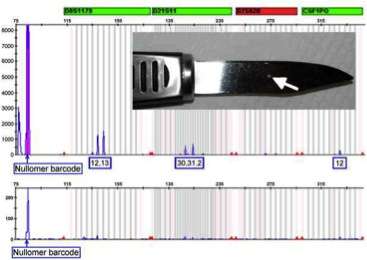Researcher reveals new way to safeguard DNA samples

(Phys.org) —DNA evidence is invisible and remarkably easy to transfer, making it possible for a sample to be spilled or even planted on a piece of evidence.
Boise State University professor Greg Hampikian is known internationally for his work in DNA forensics, and he has developed a solution that permanently marks DNA samples to prevent contamination. Hampikian has used nullomers, the smallest DNA sequences that are absent from nature, to create the DNA bar code.
He has been working on the invention for more than a decade and recently demonstrated its results for the first time in his Boise State lab. His research will be published by The Journal of Forensic and Legal Medicine. The peer-reviewed results are available pre-publication at www.sciencedirect.com/science/ … ii/S1752928X1300022X .
U.S. soldiers must give DNA samples, and Hampikian's research has been sponsored by the Department of Defense.
"The truth is that DNA contamination is a fact of life in all laboratories," Hampikian said. "This problem is compounded by techniques that make billons of copies of DNA, and new instruments that detect even just a few molecules. Unfortunately, samples taken from victims and other innocent people are still processed in the same place as samples from weapons, bodies and other evidence."
Hampikian has joint appointments in the departments of biology and criminal justice at Boise State and also is the director of the Idaho Innocence Project. In his Boise State lab, Hampikian and student and faculty collaborators work on diverse DNA projects, including developing new cancer drugs, discovering new species of single-celled organisms in Idaho, studying Basque sex chromosomes and inventing micro devices.
Several years ago, Hampikian and Boise State computer science colleague Tim Andersen identified tiny DNA and protein sequences that were absent in nature and Hampikian termed these sequences 'nullomers.' The researchers proposed that these sequences could have properties that were incompatible with life, and might serve as drugs to kill pathogens and even cancer.
The first results of nullomer-based drugs were published in October 2012 in the peer-reviewed journal Peptides and showed that these compounds killed breast and prostate cancer cells in the laboratory. Learn more at www.sciencedirect.com/science/ … ii/S0196978112004044 .
In addition, Hampikian was a key member of the Amanda Knox defense team and continues to work on cases of wrongful conviction. He also was inducted as a Charter Fellow of the National Academy of Inventors this year.
Provided by Boise State University
















